If you need to recover from Exchange mailbox database corruption, you can use an Exchange Information Store backup to do so. Before you try to restore, consider some prerequisites which must be met in order for the restore to be successful:
- You need free disk space equal to at least twice the size of the mailbox database you plan to restore (half of this is for temporary files and the other half is the restored copy of the mailbox database).
- If you want to restore back into production, you have to restore back to an Exchange server on the same domain as the original server.
- You may be able to restore to a different server than the original, but it requires some preparation.
- If you plan to restore to a recovery information store, you need to create it first.
Once you have verified these requirements are met, you can begin the restore.
Restoring an Information Store
- Log into the management portal and navigate to the Computer page. See Navigating to the Computer Page for instructions.
The Computer page is displayed.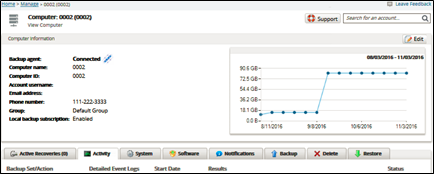
- Click the Restore tab.
The Restore Selections page is displayed.
- Click Exchange Information Store.
The Select page is displayed.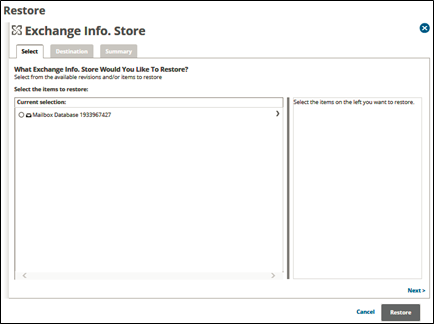
- Select from the available revisions and/or items to restore.
Clicking the arrow at the right of the items displays more revisions and items.
at the right of the items displays more revisions and items.
The selection is displayed in the far-right pane. Click the remove icon to remove any selections.
to remove any selections.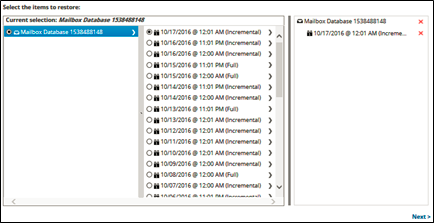
Note: You can only restore from one Exchange Server at a time.
After confirming your selections, click Next.
The Destination page is displayed.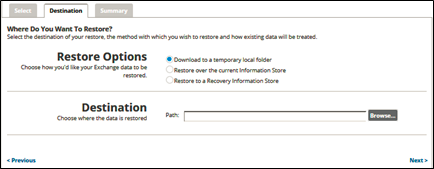
- Select a Restore Option radio button.
If you select Download to a temporary local folder, then at the Destination path field, type a path, or click the Browse button. See Browsing to a Folder.
If you select Restore over the current Information Store, the Path field is disabled.
If you select Restore to a Recovery Information Store, the Path field is disabled. - After your selections are complete, click Next.
The Summary page is displayed.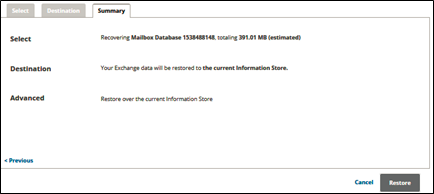
Verify the restore selections, and then click Restore.
The confirmation pop-up is displayed.
Click Yes.
The Restore Selections page is displayed with the status.
Restore Methods
There are three different Exchange Information Store restore methods. Determining which one to use comes down to picking the appropriate method for the goal of the restore. Restoring for the purposes of disaster recovery usually leads to restoring over the current information store while restoring to a temporary folder or to a recovery information store is better suited for retrieval purposes.
- Download to a temporary local folder - This option downloads the Exchange files to a folder you choose. If you want to restore a full backup by this method, select the revision and restore the files. If you want to restore an incremental backup, you need to restore the files from the most recent full backup through to that incremental revision. For example, in the window from step (5), if you wanted to restore the information store to 3/21/2016, you would need to restore the files from the full backup on 3/19/2016 and the files from the incremental backups on 3/20/2016 and 3/21/2016; each revision has to be restored separately.
- Restore over the current Information Store - When you select this method, you overwrite the information store currently on the Exchange server with the one you choose. This method replaces the current information store so be careful when restoring this way. You can pick either a full or an incremental backup to restore when using this method.
- Restore to a Recovery Information Store - If you choose to restore to a recovery information store, this method allows you to restore to a "sandbox". The recovery information store can be present alongside the production information store which allows you to transfer data between the two for restores of entire mailboxes or bulk messages. For this option to work, you need to create a recovery information store before running the restore (otherwise this option is grayed-out). You can pick either a full or an incremental backup to restore when using this method.
Creating a Recovery Information Store
The process for creating a recovery information store is relatively simple with one caveat. When creating the recovery mailbox database, the (.edb) file must have the same name as the (.edb) file you intend to restore.
If the name of our Exchange database file was "mailstore1.edb" then the command to create the recovery mailbox database should be the following (from the example here):
New-MailboxDatabase -Recovery -Name RDB -Server MBX1 -EdbFilePath "C:\Recovery\RDB\MAILSTORE1.EDB" -LogFolderPath "C:\Recovery\RDB"
...where -Name sets the name of the recovery mailbox database (this can be anything) and -Server specifies the Exchange server you are adding the recovery mailbox database to. In this example the name given to the recovery database is "RDB" and the Exchange server's name is "MBX1."
